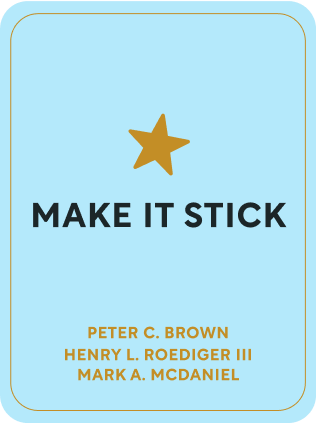

This article is an excerpt from the Shortform book guide to "Make It Stick" by Peter C. Brown, Henry L. Roediger III, Mark A. McDaniel. Shortform has the world's best summaries and analyses of books you should be reading.
Like this article? Sign up for a free trial here .
Does learning come easy to you? How do you judge your own learning competence? Do you have any beliefs about learning that could be sabotaging your progress?
In order to learn effectively, you must first clear away the illusions and myths that impede your drive to learn. Misperceptions about your competence and myths about your ability to learn can both inhibit you from pursuing greater levels of knowledge.
Read more about common learning myths and how they sabotage your ability to learn.
Balancing Intuition With Reason
Continued learning requires you to consistently strengthen and build upon your skills and knowledge. In order to expand your learning, you need to know what you know, what you don’t know, and what you need to work on.
The problem is that most people are poor judges of their own competencies. Humans are naturally prone to illusions and cognitive biases that make us blind to our shortcomings.
Humans are wired with two complementary processing systems.
- The automatic, unconscious system that’s responsible for your intuitions and knee-jerk reactions. This system is critical for situations that require split-second decisions and reflexive action, whether you’re getting away from a dangerous situation or defending against another player on the basketball court.
- The controlled, conscious system that’s responsible for logic and reason. This system works a little more slowly, helps you analyze problems, and balances the impulsivity of the first system. For example, your unconscious system notices a snake and makes you bolt away, but a few seconds later your second system kicks in and makes you realize that it’s not a snake, after all—it’s simply a garden hose.
(Shortform note: Learn more about these two systems in our summaries of Thinking, Fast and Slow and Blink.)
When your conscious system fails to correct a misperception by your unconscious system, you can end up believing illusions that make you misjudge your ability, such as:
- Perceptual illusions: Perceptual illusions distort your senses and make you misinterpret images, sounds, or other sensations. For example, pilots can encounter optical illusions or, in extreme situations, illusions that make them think the plane is flying level when it’s actually tilted.
- Cognitive biases: Cognitive biases are caused by systematic problems with your way of thinking that impact your judgment and decision making. For example, the bandwagon effect is a cognitive bias that makes people more likely to think or do something if other people think or do it.
Hunger for Narrative
Paradoxically, people sometimes unwittingly create their own illusions in an attempt to make sense of the world. People naturally want to find order and reason, so they unconsciously create narratives that explain why something is the way it is.
People also create narratives that explain events in their own lives, including circumstances they’ve faced and actions they’ve taken. For example, someone may say that no one in her family has attended college because they’re not “academic” types, which reflects the narrative she and her family have created.
Narratives are a stronger influence than objective facts, yet people fail to recognize or vastly underestimate this influence.
Myth 1: Learning Styles
One of the most common learning myths is the belief that everyone has a preferred learning style, though everyone has some ability in each area.
There are many learning styles theories and models, each defining different types of learning styles based on different criteria. A common model defines three learning styles:
- Auditory: students who learn best through oral presentations, such as lectures
- Kinesthetic: students who thrive with movement and hands-on learning
- Visual: students who gain the most from graphs and images
Many people also believe that students learn best when they’re taught according to their learning styles, but focusing on learning styles tends to limit a student’s views of her own abilities and potential. For example, if a student self-identifies as a kinesthetic learner, she’s less likely to put as much effort into a reading assignment because it supposedly doesn’t play to her strengths.
In fact, while it may be true that people have distinct preferences about the way they learn, learning isn’t inhibited if the style of teaching doesn’t match the learning style. Researchers found that the few studies that had adequately tested the theory either failed to affirm it or debunked it outright. The takeaway was that all students learn best when the instruction style matches the subject of the lesson—such as using visual means to teach geometry, audio to teach foreign language, or kinesthetic to teach physics principles on motion.
While it turns out your learning style isn’t a big factor in your ability to learn, the way you see yourself and your potential is. This is part of your narrative, which shapes how you interpret your experiences and actions. Your narrative affects your confidence to try new things, how much effort you put forth, and your perseverance in the face of obstacles.
2. Memory Is Accurate
Narratives are so strong that they shape how you interpret and remember your experiences. In other words, your memory is inherently moldable.
On one hand, your memory’s pliability is critical to your ability to learn: Everything you learn becomes a memory, and every time you recall that lesson you’re making new connections and creating new cues for that information, which further embeds it in your memory. The ability to add to your memory in this way allows you to deepen your understanding and better retain the information.
On the other hand, your tendency to create distorted memories—and fail to realize that they’re distorted—can be problematic.
Illusions of Memory
Memories are mere representations of events—not accurate recordings—and thus they easily become distorted. There’s no way you can remember every detail of an experience. Instead, you remember certain aspects, and when you call up the memory, you unconsciously fill in the details.
This lends itself to memory illusions, such as:
- Flashbulb Memories: You tend to believe that there’s no way you’d forget or mistake any detail of major, emotional events because you have a “flashbulb memory” of the experience—you recall where you were, what you did, and how you felt. However, research shows that although people tend to have the highest confidence in their most emotional memories, these are the memories that become altered the most over time.
- Hindsight Bias, or the Knew-It-All-Along Effect: When you’re reflecting on an event, you’re likely to inflate how predictable it was, even though you couldn’t have actually predicted it before it happened.
- Interference: If you’re exposed to something right before or after an experience, it can distort the memory of that experience. For example, if a witness to a crime views photos of suspects and then subsequently looks at a lineup, she’s more likely to falsely accuse someone in the lineup if she’s already seen his photo.
- Mistaking Implications for Fact: As you naturally fill in the details of your memory, you’re likely to remember things that you understood to be implied and assumed to be fact, but which may not be. For example, when you recall a meeting with your boss about your new promotion, you probably assumed that a pay raise was implied, and thus you may falsely remember your boss stating that you’d receive a raise with your new title, but that’s not the case.
- Power of Suggestion: Other people’s suggestions can heavily influence and alter your memories. For example, study participants watched a video of a car running a stop sign and hitting another car. Those who were asked how fast the car was going when it “smashed” into the second car guessed 41 miles per hour, while those who were asked how fast the car was going when it “contacted” the second car guessed 32 miles per hour. By simply changing the language of the question, researchers changed participants’ memories of the video.
- Social Contagion of Memory, or Memory Conformity: If you and a friend are recalling a joint experience, you’re likely to merge her memories with your own—even if she supposedly remembers something that didn’t actually happen. In other words, other people’s errors can contaminate your memory.
Furthermore, you can entirely fabricate memories under certain circumstances, such as:
- Feeling of Knowing: When something is familiar, you’re more likely to believe it’s true. This means that if you hear the same lie enough times, you eventually believe it’s the truth.
- Imagination Inflation: If you imagine something vividly enough, you can start to believe it happened and mistake your visualization for an actual memory.
3. False Perceptions
There are still more ways our minds trick us into misjudging our knowledge and abilities. These include:
- Curse of Knowledge: The more proficient you are in a particular skill or subject area, the more ingrained your mental models become. The more ingrained your mental models, the harder it is to break them down into individual steps in order to teach someone else, and the more likely you are to underestimate how long it will take someone to learn the skill.
- False Consensus Effect: You’re inclined to assume that other people think the way you do because you underestimate how much your individual paradigms influence the way you interpret the world. If you mistakenly assume you’re on the same page with people around you, you may fail to see the shortcomings in your performance.
- Fluency Illusions: If you easily follow a text or lecture about a topic, you may mistakenly think that your fluency with the content means you have mastery of the concepts—but, in reality, you may have just read or heard a simplified presentation of the topic.
- Misdiagnosing Problems: Sometimes, your mental models lead you astray when you encounter a problem that you think is familiar and apply your tried-and-true solution, only to find out that it’s a different kind of problem and requires a different approach. For example, brain surgeons typically have to perform surgery slowly and steadily, but if certain conditions create pressure in the brain, their patients’ lives depend on them doing the opposite and working as quickly as possible.
- Oblivious Incompetence: People who are the least competent in a given skill are often the most oblivious to their shortcomings and, thus, don’t think they need to improve. However, they can counteract this by learning how to more accurately judge their knowledge and skills.
Correct Your Faulty Competence Gauge
You’re not the best judge of your own competence, and that makes it difficult to effectively improve your knowledge and skills. But you can improve—if you know which cues to trust, which cues not to trust, and the tools to more accurately gauge your competence.
Don’t rely on these cues to judge your proficiency:
- How familiar you feel with your notes or a text
- How easily you recall information you just learned
Do use these cues to judge your proficiency:
- How easily you recall information a day or more after you learn the information
- How easily you can explain a concept or lesson in your own words
Here are some learning strategies that help you keep an accurate view of your competence:
- Apprenticeship: Learning alongside a seasoned veteran gives you a clearer view of your skill level compared to an expert’s.
- Peer Instruction: Collaborative learning with your peers helps you to avoid the kinds of misconceptions you can have when you study by yourself. An example of peer instruction is if students first read a lesson, then listen to a class lecture, which is punctuated with questions about the concepts. After spending a couple minutes on each question, students gather in small groups to discuss the answers they reached.
- Peer Review: Your fellow students or professionals can tell if you’re doing a good job or not, and if they give you honest feedback, you can adjust and improve as needed.
- Team Learning: When you work in a team of people who have complementary skills, each member of the team has an opportunity to learn from the others. Additionally, each person’s strengths are on display, and it’s often apparent if someone is falling short.
- Real-World Simulations: Training under conditions that resemble what you will face in real-life situations is the best way to hone your skills and see any gaps between conceptual learning and application.

———End of Preview———
Like what you just read? Read the rest of the world's best book summary and analysis of Peter C. Brown, Henry L. Roediger III, Mark A. McDaniel's "Make It Stick" at Shortform .
Here's what you'll find in our full Make It Stick summary :
- How to understand and remember what you learn
- How a little forgetting helps you remember
- Why you’re not a good judge of how much you know






